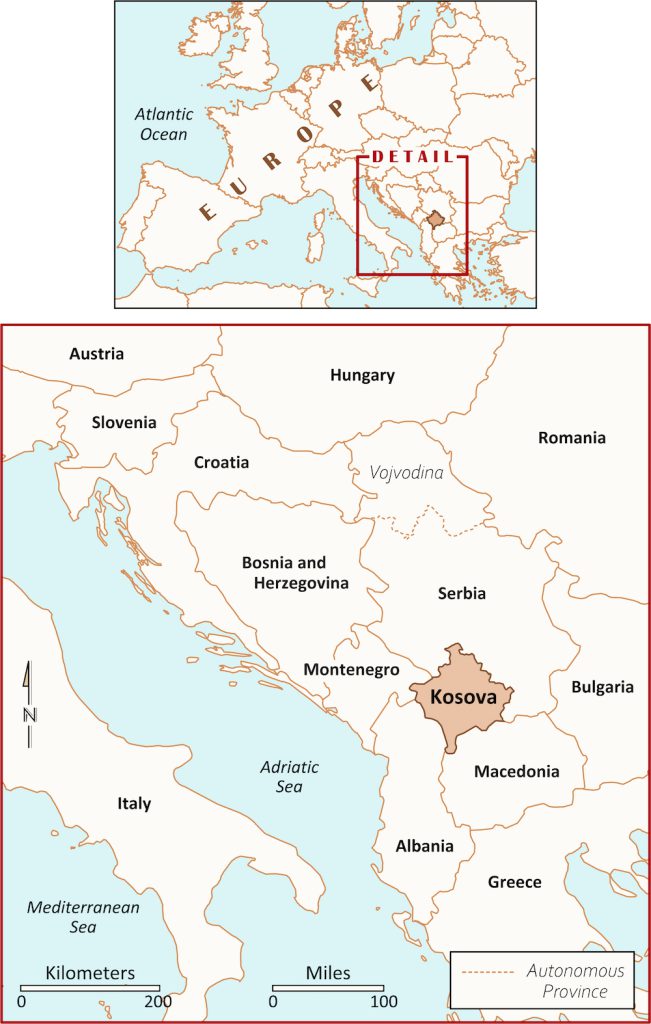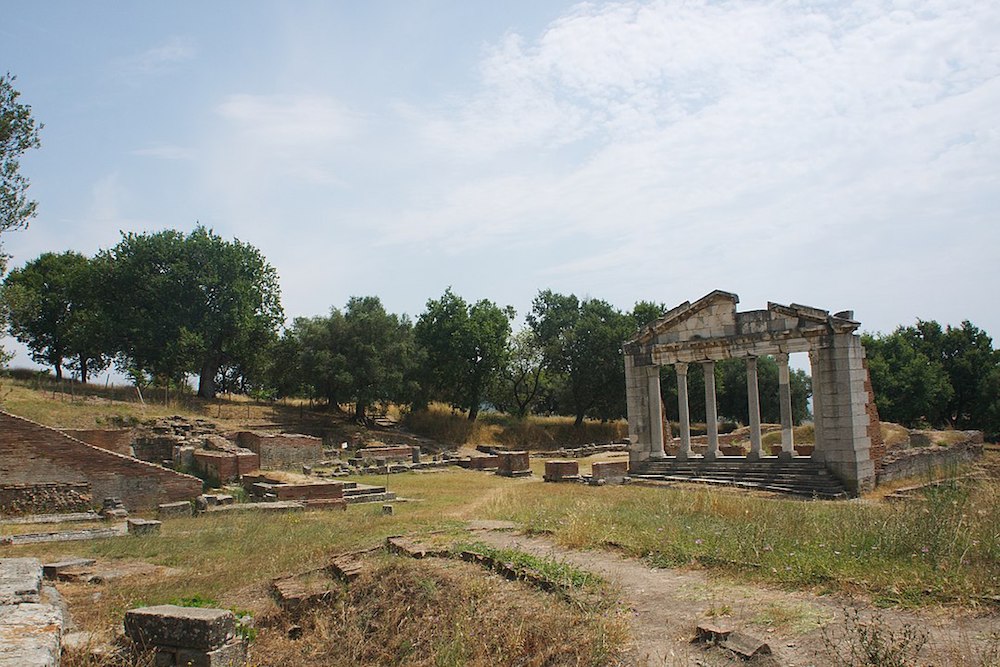Spelling a Nation’s Name

I’ve been rewriting a grant application that was rejected the first time. The grant does not provide a huge amount of money, but I need it to continue my archaeological research in the Balkans. As an international graduate student at a U.S. university without American citizenship, funding can sometimes be elusive.
Determined to be successful this time, I sent my grant proposal to a colleague to look over. One comment stood out: “Why do you use Kosova instead of Kosovo? If the reason is political—I would be careful.”
I stared at my computer screen. My colleague meant well; they did not want me to rub anyone on the deciding committee the wrong way. But the comment hit a nerve.
Someone unfamiliar with the history of the Balkans might be wondering how a letter—an “a” or an “o”—can politically charge a word.
The question eludes a simple answer. But it boils down to this: Words, especially place names, have meanings. As an archaeologist working in a “contested” part of the world, I encourage people to think about why we use certain names and place names, and what narrative they support.
Kosova is the Albanian name for Kosovo, as the country is known in Serbian. Over the centuries, colonization, annexation, conflict, war, and genocide have marked Kosova’s history and its people. By 1992, Kosova lay within the Federal Republic of Yugoslavia, which comprised Serbia and Montenegro. President Slobodan Milošević, a Serbian nationalist, oversaw the republic during the Kosovo War between 1998 and 1999.
During that time, Yugoslav and Serbian forces committed ethnic cleansing against the Albanian Kosovar people. More than 10,000 people were killed and over a million people displaced, often after being subjected to sexual assault and other war crimes. (Exact numbers have been difficult to calculate and are subject to considerable debate. For the sake of brevity, I’m only highlighting the history relevant to Kosova.)
Fast forward to the present day: Kosova, which declared independence in 2008, is aiming for full independence from Serbia. About 100 countries view Kosova as a sovereign nation, but the country seeks further international recognition.
Of course, the history of the Balkans is much more complex than a few sentences can convey. But what’s crucial to understand is that the name Kosova (as opposed to Kosovo) acknowledges not only the country’s independence from Serbia but also the Albanian Kosovar people, who have lived in the area for centuries and currently make up 90 percent of the population.
Archaeologists cannot value the pots they find in the ground while ignoring the people walking above them.
Working in Kosova as an Albanian archaeologist, I feel an obligation to the material record—and to the Kosovar people. When my survey team and I are in the field looking for artifacts from as far back as the Bronze and Iron Age periods, the landscape reminds us of the war in this country not long ago. When looking for ceramics on the ground, I can’t help but notice the destruction and sadness all around. Loss persists in the form of ruined homes, cemeteries, and war memorials.
I feel it’s unethical not to use my platform as an academic to draw attention to the history of the Albanian Kosovar people—especially when those opposed to Kosova’s independence are reportedly actively trying to enact “silent ethnic cleansing.” I cannot spend each summer conducting archaeological research in a country that welcomes me with open arms and remain apolitical. I cannot pretend I don’t see the pain in the eyes of the people we meet as they tell us about the family members they lost.
If the choice between an “a” or an “o” is a political one, then I cannot avoid being political.
Pull out your favorite navigation application on your phone and look up a map of the Balkans. How does Kosova appear? Does it appear at all?
More likely than not, the map does not represent Kosova (or Kosovo). Or, if the name does appear on the map, the label does not indicate an independent country. Perhaps the map demarcates its territory at the northern border with Serbia, but the line is faint, maybe dotted.
Apple only added a border to mark Kosova on its Apple Maps database this August. The company made this change only after close to 200,000 people, including some Albanian celebrities, signed a petition and after receiving widespread criticism on social media. Even now, the map does not represent “Kosovo” as fully independent from Serbia; its border shows up as a dotted line, and the name of the nation does not appear on the map when zoomed out.
The map below displays a more accurate representation of Kosova.
Readers may be thinking: OK but how does this relate to archaeology?
As a geographic information systems technician who uses maps and mapping software to explore archaeological questions, I know that representation matters. Maps and geospatial data can be powerful tools for shaping people’s understanding of reality.
When I started my own GIS research, I remember how frustrating it was trying to even find data that I could use. Most of the base maps and default datasets that are available in mapping software don’t represent Kosova. I’ve learned that I often have to add the borders and labels myself.
The decisions over whether to put a border or a label on a map are influenced by geopolitics. In a bid to appear apolitical and avoid offending powerful leaders, multibillion-dollar companies opt for politically safe representations. These decisions extend beyond Kosova; they happen in many other “contested” parts of the world as well, such as Palestine, Ukraine, and Kashmir. These supposedly neutral decisions often leave out certain groups, such as the people of Kosova.
The same principle applies to archaeology. In a bid to be apolitical, archaeologists—and other scientists—are often not. As much as we archaeologists would like to think of ourselves as objective, politics influence what questions we can ask, what resources are available to us, who we can collaborate with, and what conclusions we can draw.
Take, for example, the history of archaeology in Albania. For much of the latter half of the 20th century, Albania was under the Communist dictatorship of Enver Hoxha. His regime ruled with an iron fist—often murdering or persecuting political dissidents by throwing them into harsh labor camps and prisons. During that same period, the field of archaeology thrived. Some of the most famous archaeological sites in Albania were excavated and studied in detail during this time, including the Illyrian tombs of Selcë e Poshtme, the Neolithic site of Maliq, and the tumuli, or ancient burial mounds, at the Greek colony of Apollonia. Hoxha and his party members funded and supported such research because they recognized the importance of archaeology as a tool to control the narrative of national history and further their Communist Party agenda.
There are well-known cases too: Adolf Hitler’s Third Reich in Germany is an often-cited example of what happens when archaeological data is taken out of context and manipulated to fuel racist policies and, in this example, anti-Semitic violence.
These affiliations by archaeologists with historical atrocities have been used to argue that politics has no place in the sciences. But I think these examples prove the opposite. Scientists need to remain politically conscious in order to prevent dangerous events from happening in the first place.
Archaeologists are trained to deal with the difficulties of unpacking deep time. But it’s clear that as a field, we could work more on understanding the complexities of the present. The same point holds true for anyone who wants to understand how events such as wars and genocides continue to reverberate years later.
In Kosova, I sometimes come across dilapidated homes that are still stained by the smoke and soot from fires that destroyed them during wartime. The people, furniture, and everyday objects that once filled such homes are now missing, either displaced or vanished. Other times, the reminders of war are smaller in scale—a stray bullet found in a sunbaked field. My stomach turns every time I find one; I always hope I’ve uncovered a remnant from target practice, not war.
But life, somehow, goes on. Run-down walls are covered with new growth—nature reclaiming culture.
The layered landscapes of Kosova have shown me that the past does not exist in isolation. Archaeological research may focus on people who are long gone, but archaeologists interact with the living. The political, historical, and social undercurrents of where we work have implications for researchers’ findings today.
Archaeologists cannot value the pots they find in the ground while ignoring the people walking above them.
I am not saying that archaeologists and other scientists need to enter the field with political agendas. But we need to be conscious of the narratives we might be inadvertently supporting by simply following the status quo. In turn, people who rely on science to understand the world should take a critical eye toward how politics can influence seemingly objective representations of reality, such as maps.
I will not buy into the dominant narrative, the path of least resistance; I refuse the premise that science is apolitical. As an individual and as an academic, I make choices about which narratives I want to perpetuate.
My grant proposals will always say “Kosova.” My maps will always include a solid border demarcating Kosova’s territory. In these seemingly small acts, I stay true to myself and to the people of the country where I have the privilege to work.



































